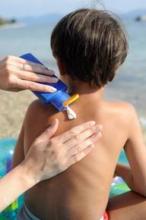As the weather warms up and spring break is upon us, it is again time to remind parents about the importance of sun protection. While most families think about this at the height of summer – in their bathing suits at the beach – children should wear sunscreen anytime they are outside to play. This means that spring soccer practice, afternoons at the playground, and running around in the backyard are all times when sun damage can occur. Yet with all the choices available to parents, many are understandably confused.
As a general rule, all children – regardless of age or skin tone – should avoid the sun during its strongest hours, wear hats and light clothing to cover skin in the sun, and, for children over age 6 months, wear sunscreen when outside. And of course, they should avoid deliberate sun tanning and tanning beds.
Type of Sunscreen
In recent years, it has become clear that both UVB and UVA rays can cause skin damage. For many years, UVA rays were thought to cause photoaging but not significantly contribute to the development of skin cancer. However, this has been shown to be inaccurate.
As of June 18, there will be new labeling rules. Sunscreens that protect against ultraviolet A(UVA) and ultraviolet B (UVB) will be labeled "broad spectrum." Only sunscreens that are both broad spectrum and have an SPF (Sun Protection Factor) of 15 or higher will be able to include labeling that says it helps prevent skin cancer and protects against skin aging. Sunscreens with an SPF of 2 to 14 can still be labeled broad spectrum if they meet the FDA tests for UVA and UVB protections, but they must warn that they haven't been shown to provide protection against skin cancer or early skin aging.*
Level of SPF
Most experts suggest that an SPF of at least 15 is needed. However, the products only provide the labeled protection if the sunscreen is correctly applied (2 mg/cm – a very thick layer). Most people apply less than half of what is recommended, so a product of at least SPF 30 is recommended. My experience is that most parents feel that "more is better," and look for the highest SPF product they can find – and many are willing to pay top dollar for it. My feeling is that you don’t get much additional benefit for the superhigh-SPF products, and your money is better spent elsewhere. To get maximum benefit, be sure to apply sunscreen frequently (at least every 2 hours or so), cover all exposed areas of the body, and put it on at least 15-30 minutes before going outside. In addition, always reapply sunscreens after going in the water, even sunscreens marked waterproof.
Infants and Young Children
There is little information about the safety and efficacy of sunscreen in children less than 6 months of age, so it is generally recommended to avoid using it. Instead, infants should be kept out of the sun as much as possible (and remember, the American Academy of Pediatrics does recommend Vitamin D supplementation for infants). If sun exposure is unavoidable, then it is recommended that sunscreen be applied on small and exposed areas of the skin (whatever isn’t covered by clothing ... loose but tightly woven is generally best). Infants and young children also may have more sensitive skin, so looking for products with fewer additives can be helpful. They also tend to rub at their eyes, so thicker preparations will be less likely to irritate.
If all this seems overwhelming to you as a provider, imagine how a parent feels trying to choose a sunscreen before the kids knock them all off the shelves, and then convincing the child to sit still long enough to actually apply the recommended amount! Hopefully, a few tidbits of guidance from you will simplify their choices and allow the whole family to just focus on getting out, moving, and having fun.
Dr. Beers is assistant professor of pediatrics at Children’s National Medical Center in Washington. She is a member of the Pediatric News editorial advisory board, a member of the American Academy of Pediatrics Committee on Residency Scholarships, and president-elect of the District of Columbia chapter of the American Academy of Pediatrics. She said she had no relevant financial disclosures. E-mail Dr. Beers at pdnews@elsevier.com.
* Updated: New information was added 4/12/2012


